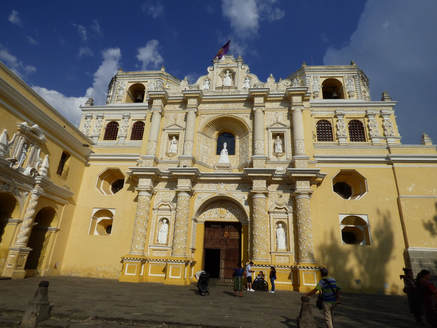26th February
 Azure-crowned Hummingbird
Azure-crowned Hummingbird
We breakfasted at 6 a.m., and then whilst waiting in the courtyard to depart, we saw our first hummer in the shape of an Azure-crowned Hummingbird. There was also a Clay-coloured Thrush sitting in the central tree. This morning we drove up into the hills above Antigua, to the delightful Finca el Pilar private reserve which comprises in the main, pine-oak forest. The farm is dedicated to conservation and has a series of well marked trails. For a large part of the morning we birded around a clearing near some buildings and soon started racking up new species for all of us. Favourites of mine in this area were Grey Silky-flycatcher, Inca Dove, Golden-olive Woodpecker, Bushy-crested Jay, Black-capped Swallow, Black-vented Oriole, Rufous-collared Thrush, and Yellow-winged Tanager. Nearctic species also featured - this being Central America, many species winter here. Amongst these were 'my' Warbler [Wilson's :-) ], Tennessee and Townsend's Warblers, Western Tanager, Indigo Bunting, and the local mexicanoides subspecies of Northern Flicker. There were a good number of Eastern Bluebirds too. Flycatchers featured as well - Greater Pewee, and Least, Dusky-capped and Hammond's Flycatchers. It's amazing to think that I have seen the latter way up north in British Columbia. Last but not least was a Black-headed Siskin. Satisfied with our finds we set off downhill to find the hummingbird feeders, and on the way we found a Collared Trogon, the first of four species we eventually saw. We arrived at the feeders which weren't ideally placed for photography as they were above and to one side of the path, but nevertheless within a couple of minutes our main target arrived, in the form of a Rufous Sabrewing. This is an endemic species limited to the area from the Chipias state of Mexico, down to El Salvador. Other hummers seen here were Azure-crowned, and Rivoli's, and farther up the trail, Green-throated Mountaingem. After a great first morning we dropped back down to Antigua to have lunch and a short siesta.
 Iglesia de la Merced
Iglesia de la Merced
This afternoon, Maynor took us on a guided walk around Antigua as it is usually known. It's a long story but the city was the third capital city of Guatemala. The immediately previous capital was destroyed by a devastating pyroclastic flow from the nearby Volcan Fuego, [which we had impressive views of in the morning], so it was moved and the current location of Antigua Guatemala was chosen. Eventually Antigua itself [then called Santiago de los Caballeros] was hit by three different earthquakes, in 1717, 1751 and 1773, all associated with eruptions of Volcan Fuego. Hence in 1776 the Spanish Crown ordered the relocation of the capital city to the location which is now known as Guatemala City. However over time the old city of Antigua was rebuilt and has now become a World Heritage Site, of which Maynor is rightly very proud, as was evidenced as he took us around. The city is laid out in a grid formation with pretty narrow cobbled streets and beautiful ornate Spanish colonial styled buildings. There is a pleasant park area in the centre where we encountered a group of Pacific Parakeets, a Peregrine, an Inca Dove, and a male Rose-breasted Grosbeak feeding on tree buds. After a delicious evening meal we crashed, ready for whatever tomorrow held in store.








